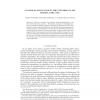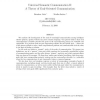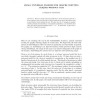84 search results - page 1 / 17 » Canonical structure in the universe of set theory: part one |
APAL
2004
13 years 4 months ago
2004
Abstract. We start by studying the relationship between two invariants isolated by Shelah, the sets of good and approachable points. As part of our study of these invariants, we pr...
APAL
2006
13 years 4 months ago
2006
We prove a number of consistency results complementary to the ZFC results from our paper [4]. We produce examples of non-tightly stationary mutually stationary sequences, sequences...
ECCC
2008
13 years 4 months ago
2008
We continue the investigation of the task of meaningful communication among intelligent entities (players, agents) without any prior common language. Our generic thesis is that su...
AML
2010
13 years 5 months ago
2010
When no single universal model for a set of structures exists at a given cardinal, then one may ask in which models of set theory does there exist a small family which embeds the r...
SIAMCOMP
1998
13 years 4 months ago
1998
A chain of a set P of n points in the plane is a chain of the dominance order on P. A k-chain is a subset C of P that can be covered by k chains. A k-chain C is a maximum k-chain ...



